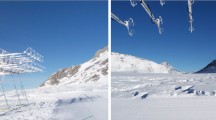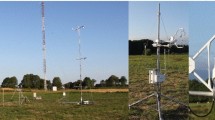Abstract
The physicist and mathematician Shang-Keng Ma once commented that “the simplest possible variable is one that can have two values. If there is only one value, no variation is possible." Guided by this dictum, the telegraphic approximation (TA) is applied to the streamwise velocity component and air temperature time series acquired in the first metre above the salt flats of Utah, USA. The TA technique removes amplitude variations and retains only zero-crossing behaviour in a turbulent series, thereby allowing for an isolated examination of the role of clustering in intermittency. By applying the TA technique, clustering properties are analyzed to uncover dissimilarity in temperature and velocity across unstable, near-neutral, and stable atmospheric stratification. The spectral exponents of the original and of the TA series are examined, with the inertial-subrange behaviour conforming to prior empirical relations and the energy-containing range exhibiting deviations. These two distinct scale regimes are observed in the standard deviations of the running density fluctuations of the TA series, delineating scaling behaviour between fine and large scales. In the fine scales, clustering is not appreciably affected by the stability regime and is higher than in the large scales. In the large scales, the temperature series exhibits stronger clustering with increasing stability, and higher clustering compared with the streamwise velocity component series under stable conditions. Amplitude variations are shown to mitigate intermittency in the small scales of velocity, but play only a minor role in intermittency for temperature. Last, the inter-pulse period probability distributions are explored and implications to self-organized criticality as models for TA turbulence are discussed.












Similar content being viewed by others
References
Anfossi D, Öttl D, Degrazia G, Goulart L (2005) An analysis of sonic anemometer observations in low wind speed conditions. Boundary-Layer Meteorol 114(1):179–203
Antonia R, Abe H, Kawamura H (2009) Analogy between velocity and scalar fields in a turbulent channel flow. J Fluid Mech 628:241
Arwatz G, Fan Y, Bahri C, Hultmark M (2015) Development and characterization of a nano-scale temperature sensor (T-NSTAP) for turbulent temperature measurements. Meas Sci Technol 26(3):035103
Bak P, Tang C, Wiesenfeld K (1988) Self-organized criticality. Phys Rev A 38(1):364
Banerjee T, Katul G (2013) Logarithmic scaling in the longitudinal velocity variance explained by a spectral budget. Phys Fluids 25(12):125106
Bendat JS, Piersol AG (2011) Random data: analysis and measurement procedures, vol 729. Wiley, New York
Bershadskii A, Niemela J, Praskovsky A, Sreenivasan K (2004) “Clusterization” and intermittency of temperature fluctuations in turbulent convection. Phys Rev E 69(5):056314
Cava D, Katul G (2009) The effects of thermal stratification on clustering properties of canopy turbulence. Boundary-Layer Meteorol 130(3):307
Cava D, Katul GG, Molini A, Elefante C (2012) The role of surface characteristics on intermittency and zero-crossing properties of atmospheric turbulence. J Geophys Res Atmos 117(D1):D01104
Cava D, Mortarini L, Giostra U, Acevedo O, Katul G (2019) Submeso motions and intermittent turbulence across a nocturnal low-level jet: A self-organized criticality analogy. Boundary-Layer Meteorol 172(1):17–43
Celani A, Lanotte A, Mazzino A, Vergassola M (2001) Fronts in passive scalar turbulence. Phys Fluids 13(6):1768–1783
Chambers A, Antonia R (1984) Atmospheric estimates of power-law exponents \(\mu \) and \(\mu _{\theta }\). Boundary-Layer Meteorol 28(3–4):343–352
Chamecki M (2013) Persistence of velocity fluctuations in non-Gaussian turbulence within and above plant canopies. Phys Fluids 25(11):115110
Chamecki M, Dias NL, Salesky ST, Pan Y (2017) Scaling laws for the longitudinal structure function in the atmospheric surface layer. J Atmos Sci 74(4):1127–1147
Chowdhuri S, Kalmár-Nagy T, Banerjee T (2020) Persistence analysis of velocity and temperature fluctuations in convective surface layer turbulence. Phys Fluids 32(7):076601
Citriniti J, George W (1997) The reduction of spatial aliasing by long hot-wire anemometer probes. Exp Fluids 23(3):217–224
Fan Y, Arwatz G, Van Buren T, Hoffman D, Hultmark M (2015) Nanoscale sensing devices for turbulence measurements. Exp Fluids 56(7):138
Gao W, Shaw R, et al (1989) Observation of organized structure in turbulent flow within and above a forest canopy. In: Boundary layer studies and applications. Springer, pp 349–377
Garratt JR (1994) The atmospheric boundary layer. Cambridge University Press, Cambridge
Giostra U, Cava D, Schipa S (2002) Structure functions in a wall-turbulent shear flow. Boundary-Layer Meteorol 103(3):337–359
Heisel M, Katul GG, Chamecki M, Guala M (2020) Velocity asymmetry and turbulent transport closure in smooth-and rough-wall boundary layers. Phys Rev Fluid 5(10):104605
Huang KY, Brunner CE, Fu MK, Kokmanian K, Morrison TJ, Perelet AO, Calaf M, Pardyjak E, Hultmark M (2021) Investigation of the atmospheric surface layer using a novel high-resolution sensor array. Exp Fluids 62(76):76
Hutchins N, Chauhan K, Marusic I, Monty J, Klewicki J (2012) Towards reconciling the large-scale structure of turbulent boundary layers in the atmosphere and laboratory. Boundary-Layer Meteorol 145(2):273–306
Jensen HJ, Christensen K, Fogedby HC (1989) 1/f noise, distribution of lifetimes, and a pile of sand. Phys Rev B 40(10):7425
Kailasnath P, Sreenivasan K (1993) Zero crossings of velocity fluctuations in turbulent boundary layers. Phys Fluids 5(11):2879–2885
Katul GG (1994) A model for sensible heat flux probability density function for near-neutral and slightly-stable atmospheric flows. Boundary-Layer Meteorol 71(1):1–20
Katul G, Porporato A, Cava D, Siqueira M (2006) An analysis of intermittency, scaling, and surface renewal in atmospheric surface layer turbulence. Physica D 215(2):117–126
Katul G, Konings A, Porporato A (2011) Mean velocity profile in a sheared and thermally stratified atmospheric boundary layer. Phys Rev Lett 107(26):268502
Katul G, Porporato A, Nikora V (2012) Existence of \(k^{-1}\) power-law scaling in the equilibrium regions of wall-bounded turbulence explained by Heisenberg’s eddy viscosity. Phys Rev E 86(6):066311
Klewicki J, Foss J, Wallace J (1998) High Reynolds number [\({R}_\theta \)= O(\(10^6\))] boundary layer turbulence in the atmospheric surface layer above western Utah’s salt flats. In: Flow at ultra-high Reynolds and Rayleigh numbers. Springer, pp 450–466
Li Q, Fu Z (2013) The effects of non-stationarity on the clustering properties of the boundary-layer vertical wind velocity. Boundary-Layer Meteorol 149(2):219–230
Li D, Katul G, Gentine P (2016) The \(k^{-1}\) scaling of air temperature spectra in atmospheric surface layer flows. Q J R Meteorol Soc 142(694):496–505
Liu L, Hu F (2020) Finescale clusterization intermittency of turbulence in the atmospheric boundary layer. J Atmos Sci 77(7):2375–2392
Lumley J, Yaglom A (2001) A century of turbulence. Flow Turbul Combust 66(3):241–286
Marusic I, Monty JP, Hultmark M, Smits AJ (2013) On the logarithmic region in wall turbulence. J Fluid Mech 716:R3
Metzger M, Klewicki J (2001) A comparative study of near-wall turbulence in high and low Reynolds number boundary layers. Phys Fluids 13(3):692–701
Morrison T, Calaf M, Higgins C, Drake S, Perelet A, Pardyjak E (2021) The impact of surface temperature heterogeneity on near-surface heat transport. Boundary-Layer Meteorol. https://doi.org/10.1007/s10546-021-00624-2
Obukhov A (1962) Some specific features of atmospheric turbulence. J Geophys Res 67(8):3011–3014
Perry AE, Henbest S, Chong MS (1986) A theoretical and experimental study of wall turbulence. J Fluid Mech 165:163–199
Poggi D, Katul G (2009) Flume experiments on intermittency and zero-crossing properties of canopy turbulence. Phys Fluids 21(6):065103
Pope SB (2000) Turbulent flows. Cambridge University Press, Cambridge
Salesky S, Katul G, Chamecki M (2013) Buoyancy effects on the integral lengthscales and mean velocity profile in atmospheric surface layer flows. Phys Fluids 25(10):105101
Shi B, Vidakovic B, Katul G, Albertson J (2005) Assessing the effects of atmospheric stability on the fine structure of surface layer turbulence using local and global multiscale approaches. Phys Fluids 17(5):055104
Shraiman B, Siggia E (2000) Scalar turbulence. Nature 405(6787):639–646
Sreenivasan K (1991) On local isotropy of passive scalars in turbulent shear flows. Proc R Soc 434(1890):165–182
Sreenivasan KR, Antonia R (1997) The phenomenology of small-scale turbulence. Annu Rev Fluid Mech 29(1):435–472
Sreenivasan K, Bershadskii A (2006) Clustering properties in turbulent signals. J Stat Phys 125(5–6):1141–1153
Sreenivasan K, Prabhu A, Narasimha R (1983) Zero-crossings in turbulent signals. J Fluid Mech 137:251–272
Sreenivasan K, Bershadskii A, Niemela J (2004) Multiscale SOC in turbulent convection. Phys A Stat Mech Appl 340(4):574–579
Townsend A (1976) The structure of turbulent shear flow. Cambridge University Press, Cambridge
Vallikivi M, Smits AJ (2014) Fabrication and characterization of a novel nanoscale thermal anemometry probe. J Microelectromech Syst 23(4):899–907
Vallikivi M, Hultmark M, Smits AJ (2015) Turbulent boundary layer statistics at very high Reynolds number. J Fluid Mech 779:371
Warhaft Z (2000) Passive scalars in turbulent flows. Annu Rev Fluid Mech 32(1):203–240
Wei T, Fife P, Klewicki J, McMurtry P (2005) Properties of the mean momentum balance in turbulent boundary layer, pipe and channel flows. J Fluid Mech 522:303–327
Wyngaard JC (2004) Changing the face of small-scale meteorology. In: Atmospheric turbulence and mesoscale meteorology. Cambridge University Press, Cambridge
Zorzetto E, Bragg A, Katul G (2018) Extremes, intermittency, and time directionality of atmospheric turbulence at the crossover from production to inertial scales. Phys Rev Fluids 3(9):094604
Acknowledgements
This work was supported by the NSF-AGS-1649049. K. Huang was supported by the Department of Defense (DoD) through the National Defense Science and Engineering Graduate Fellowship (NDSEG) program, and G. Katul was supported by the NSF-AGS-1644382, NSF-AGS-2028644 and NSF-IOS-1754893. The authors also acknowledge Princeton University’s Metropolis Project for partial support during Katul’s sabbatical leave at Princeton University in 2020. The authors would also like to thank Matthew K. Fu for his help in editing this paper.
Author information
Authors and Affiliations
Corresponding author
Additional information
Publisher's Note
Springer Nature remains neutral with regard to jurisdictional claims in published maps and institutional affiliations.
Rights and permissions
About this article
Cite this article
Huang, K.Y., Katul, G.G. & Hultmark, M. Velocity and Temperature Dissimilarity in the Surface Layer Uncovered by the Telegraph Approximation. Boundary-Layer Meteorol 180, 385–405 (2021). https://doi.org/10.1007/s10546-021-00632-2
Received:
Accepted:
Published:
Issue Date:
DOI: https://doi.org/10.1007/s10546-021-00632-2




